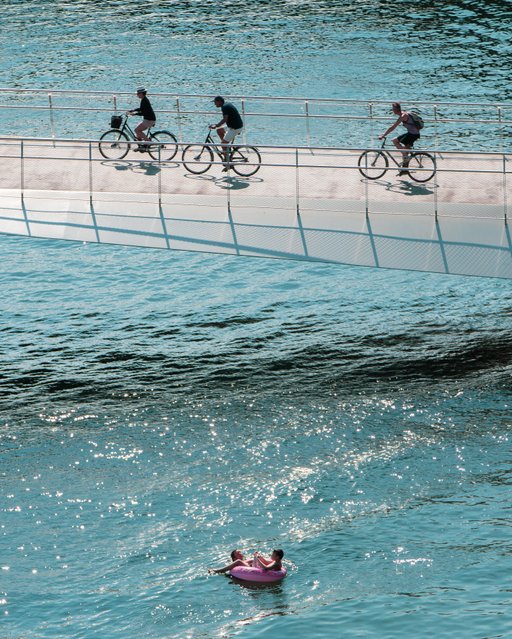Featured Image: Copenhagen Media Center – Daniel Rasmussen
- How does MaaS align with emerging priorities for European Cities?
- How can congested European cities apply policies to create attractive and integrated alternatives whilst deterring personal cars?
- What can Europe’s top cycling cities teach us about how infrastructure can support mobility innovation?
As the vaccine slowly but surely allows European cities to ease out of lockdowns, there is a need to ensure people feel safe and excited to return to normal life. Euromonitor predicts a rise in ‘making the urban rural’ as people seek clean air and green spaces in cities to enhance mental and physical wellbeing[1]. Additionally, they report that ‘Safety Obsessed’ is a new facet of public consciousness borne out of Covid-19 driving demand for safe and efficient cities which can function socially distanced if necessary. Public transport may not be able to operate at full capacity due to risk of infection, and a general aversion to packed public spaces creates vast opportunities for other forms of city transport. The pandemic has accelerated mobility policies that were already being discussed in the future tense; many congested cities are trialing space re-allocation policies which deter car usership during the relative calm of the lockdowns. Changing city infrastructure could lend itself to multi-modal journeys and integrated transport networks that Mobility as a Service (MaaS) hopes to achieve. The concept of MaaS – particularly micromobility – offers multi-fold benefits for rethinking cities as lockdowns lift. People can enhance wellbeing and time spent in green spaces by using bikes and e-scooters to travel, and these provide an alternative or complimentary service to public transport.

Milan, Paris, Berlin and London are all trialing cycle lanes on major city routes, and have recently announced plans to expand permanent bike and pedestrian paths. These decisions reflect efforts from cities across Europe to minimise personal car access to central roads. Deterring cars is the first step to reducing congestion and lowering emissions, but city planning should aim to think radically beyond traditional mobility structures in order to accommodate future mobility needs. Infrastructure has the potential to enhance uptake of alternative mobility and compliment a MaaS system by supporting technological innovation on the ground. In the top European cities for cycling, world leading infrastructure for bikes is a key reason they see such high levels of usership. These examples should form a reference point for cities as they move away from privileging cars on roads, towards embracing innovation and emerging technology in the mobility sector.

In Copenhagen, where half of all trips to work and study are taken by bike[3], there are purpose-built bridges which form cycling super-highways across the city, bike tire pumps placed outside stations, and trains are optimised for bike access. Compartments with folding seats can hold up to 60 bikes per train, and in 2010 it became free to take bikes on the S-train. The number of passengers taking a bike on board rose from 2.1 million to 9 million in just six years following these changes[4], demonstrating how effective policy can accelerate behaviour change by improving convenience and cost. For e-bikes and scooters, stations could be placed outside public transport stations to increase convenience of multi-modal journeys. Increased infrastructure for bikes has had significant impact on reducing emissions in Copenhagen through reducing daily car journeys, as well as a notable wellbeing benefits for those who use cycling as a mode of transport.
In Malmö, Sweden, cycle paths are named like streets to allow for GPS mapping which can support improved journey planning on an app. Helsinki have invested in over 1300km of cycle lanes, and old railway tracks have been converted into The Baana – meaning ‘The railroad” – which forms a cycle corridor for longer journeys across the city. Given the strength of investment in cycling infrastructure, it is no coincidence that the Helsinki bike-share scheme has become a European shared mobility success story. During the first two weeks of the 2017 season, the scheme recorded 13,000 registered users and 6,000 trips a day, with 60% of users regularly combining trips with other forms of public transit.[5] Micromobility has the potential to build on these benefits if bolstered by innovative infrastructure. E-bikes and scooters can make shorter journeys faster and accessible to all because they require less strenuous activity and users don’t have to buy and maintain a bicycle.

Rethinking mobility as an integrated system which can support the demands of growing populations in cities calls for future-facing infrastructure strategy which is geared towards innovation. Cities should strive to make multi-modal journeys seamless for both bikes and micromobility in order to create attractive and accessible alternatives to personal cars. This will require a tailored approach as every European city has unique challenges and historic urban landscapes to plan mobility around. For some cities this may mean investing in purpose built transport links for alternative mobility, for others – as seen in Helsinki – there is great potential to repurpose existing infrastructure to meet new mobility needs. Lockdown has presented an opportunity to experiment with re-allocating road space, however in order to tackle congestion in the long run, cities must strive to efficiently connect existing and new modes of transport rather than have them operate at loggerheads on roads.
[1] Bertoli, A., 2017. Helsinki Bikeshare Program Triples After Successful Launch. [online] CleanTechnica.
[2] Cycling Embassy of Denmark. 2018. Danish cycling statistics – Cycling Embassy of Denmark.
[3] The Life Sized City, 2016. Massive Passenger Increase After Bikes Allowed Free on Trains.
[4] Euromonitor International, 2021. Top 10 Global Consumer Trends 2021.
[5] Bertoli, A., 2017. Helsinki Bikeshare Program Triples After Successful Launch. [online] CleanTechnica.





